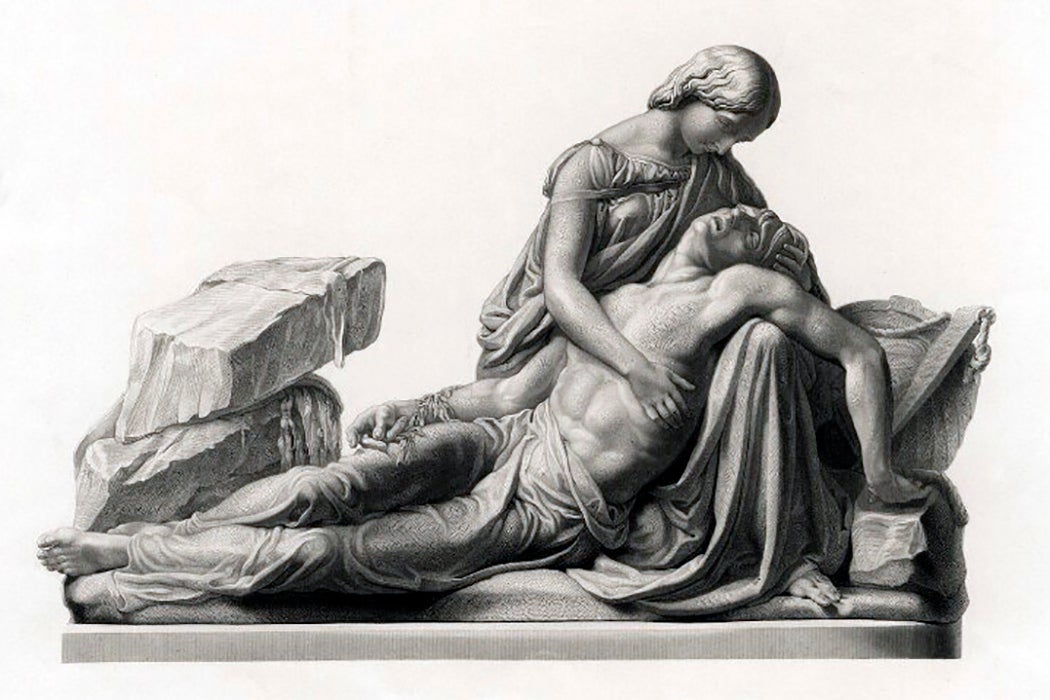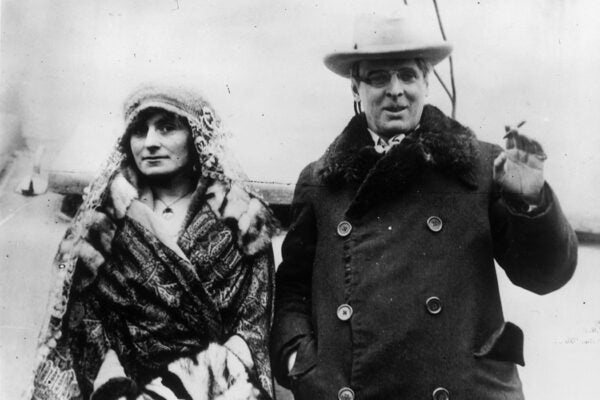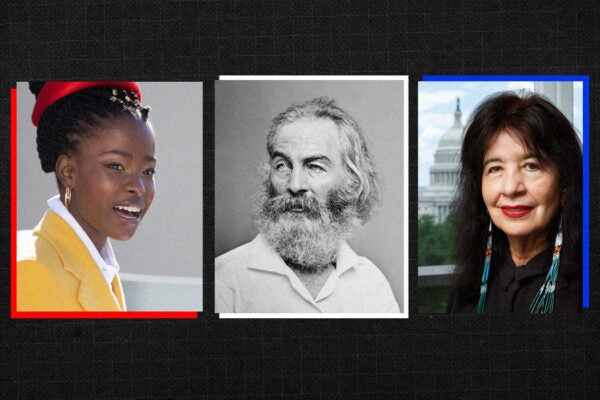In her 1831 introduction to Frankenstein, Mary Shelley explains: “It is not singular that, as the daughter of two persons of distinguished literary celebrity, I should very early in life have thought of writing.” She is answering an oft-asked question—the nineteenth-century equivalent of “What’s a nice girl like you doing writing gross stuff like this?”—and the fact that she begins by mentioning her parents is a sign of how greatly they figured in her sense of self.
Yet only one of Mary Shelley’s parents lived to see Frankenstein published. Mary Wollstonecraft Godwin, the brilliant feminist best known for A Vindication of the Rights of Women, died shortly after giving birth to Mary, a fact that haunted her daughter for the rest of her life. Baby Mary, however, was not the fatal agent: It was the physician, one Dr. Poignand, who removed the placenta piece by piece with unwashed hands, and who transmitted the puerperal fever that killed Wollstonecraft Godwin days after giving birth. (In light of her daughter’s creative output, it’s worth mentioning that puerperal fever was then often transmitted by doctors proceeding directly from autopsies to births.)
After that, Mary Shelley’s “only real ‘mother’ was a tombstone,” as Sandra M. Gilbert writes. The remark is not as figurative as it may first appear: Mary spent a considerable amount of time at her mother’s grave in the St. Pancras churchyard, reading her mother’s work. Her father, the reformist writer and philosopher William Godwin, first took her to the churchyard when she was a child, and Mary continued visiting on her own, especially after father married his next-door-neighbor Mary Jane Clairmont—whom Mary found insufferable—and her home life became considerably strained.
“Especially because she never knew her mother … her principal mode of self-definition—certainly in the early years of her life with Shelley, when she was writing Frankenstein—was through reading,” Gilbert says. “Endlessly studying her mother’s works and her father’s, Mary Shelley may be said to have ‘read’ her family and to have been related to her reading, for books appear to have functioned as her surrogate parents, pages and words standing in for flesh and blood.” And much of Mary’s reading during her younger years took place in the graveyard.
The cemetery took on a new relevance when Percy Shelley burst upon the scene. The Godwins maintained an intellectual household, with visitors such as the radical essayist William Hazlitt, the painter Thomas Lawrence, the chemist Humphry Davy, and the poet Samuel Taylor Coleridge (who once allowed Mary and her stepsister to hear a recitation of The Ancient Mariner after the pair were discovered hiding under the sofa). But no one had as much influence on Mary as Percy, a fervent admirer of her father’s, who came for dinner one night in late 1812. The pair met again in 1814 and, despite the fact that Mary was only 16 and the 21-year-old poet was married (to another 16-year-old), began taking walks together in the St. Pancras churchyard. Mary was attracted by his idealism, fearlessness and what his friend Thomas Jefferson Hogg called his “wild, intellectual, unearthly” looks.
The Godwins probably assumed that Mary and Percy were “simply reaffirming their reformist ideals” in the graveyard, writes Mary’s biographer Martin Garrett. In fact, they were doing a bit more than that: The pair declared their love for each other there that June, and shortly thereafter had sex for the first time, which “tradition affirms” was in the churchyard, according to Garrett.
“Her mother’s grave: the setting seems an unusually grim, even ghoulish locale for reading, writing, or love-making,” Gilbert notes. Yet for Mary Shelley, the cemetery was not merely a repository of rotting corpses, but a site of knowledge and connection: It was a place where she read to deepen her literary education and her communion with her mother, and a place where she was inducted into mysteries of sexuality. Literary, familial, and carnal knowledge were all bound together in one place.
The idea of the cemetery as a site of (sometimes forbidden) knowledge shows up in her most famous work. As a student, Victor Frankenstein supplements his study of chemistry and anatomy with trips to the graveyard, explaining: “To examine the causes of life, we must first have recourse to death.” The cemetery, or at least its gleanings, is the site of Victor’s greatest aha moment, upon which the rest of the novel depends:
Now I was led to examine the cause and progress of this decay and forced to spend days and nights in vaults and charnel-houses … I beheld the corruption of death succeed to the blooming cheek of life; I saw how the worm inherited the wonders of the eye and brain. I paused, examining and analyzing all the minutiae of causation, as exemplified in the change from life to death, and death to life, until from the midst of this darkness a sudden light broke in upon me—a light so brilliant and wondrous, yet so simple, that while I became dizzy with the immensity of the prospect which it illustrated, I was surprised that among so many men of genius who had directed their inquiries towards the same science, that I alone should be reserved to discover so astonishing a secret.
The secret, of course, is that of life itself—of how the “component parts of a creature might be manufactured, brought together, and endued with vital warmth,” as Mary writes in her introduction. The fact that Frankenstein’s monster is assembled from fragments of corpses has a parallel in Mary’s assembly of her own self-identity: in some sense she is like her own creature, without a mother, assembling herself out of dead fragments in the form of books.
Frankenstein, too, is assembled out of fragments—the book is constructed as a series of potted narratives, texts within texts. Indeed, Gilbert connects the “evidentiary technique” of the novel to Shelley’s attempts to understand sex, which first took place in the graveyard: “[R]eading and assembling documentary evidence, examining it, analyzing it, researching it, was for Shelley a crucial if voyeuristic method of exploring origins, explaining identity, understanding sexuality.”
As Gilbert notes, there are other ways to read Frankenstein’s monster as a stand-in for Mary Shelley—and for femaleness in general. While pop culture loves to fixate on Victor as the mad scientist, some of the most moving parts of the book come from the monster’s monologue, which Gilbert reads as “a philosophical meditation on what it means to be born without a ‘soul’ or a history, as well as an exploration of what it feels like to be a ‘filthy mass that move[s] and talk[s], a thing, an other, a creature of the second sex.'”
She finds the fact that the monster reads Plutarch’s Lives significant as a means of introducing him to the capital-H history his unusual parentage has denied him—the type of history women that have also so often been excluded from. (“What is woman but man without a history, at least without the sort of history related in Plutarch’s Lives,” Sandra M. Gilbert and Susan Gubar write in The Madwoman in the Attic.) For Mary Shelley in particular, suffering the loss of her mother and feeling herself excluded from her father’s household after his remarriage, the idea of being born without a history—or at least bound to a history that has been suppressed or altered—likely carried a particular poignancy.
Get Our Newsletter
Reading, too, can be an act of resurrection. Mary knew this in part thanks to her father. Godwin’s Essay on Sepulchres (1809) argued in favor of erecting memorials on the graves of the “illustrious dead” and instituting what the scholar Paul Westover calls a program of “necro-tourism” in Great Britain. Westover writes that for Godwin, “old books are the bodies ghosts possess,” and that “to read is to meet the shades of departed authors”—an attitude his daughter likely took to heart. Yet reading was only one form of communication with the dead: Godwin also believed in the power of visiting material remains, as clearly his daughter did too. “[The dead] still have their place, where we may visit them, and where, if we dwell in a composed and a quiet spirit, we shall not fail to be conscious of their presence,” he writes.
Mary shows something of this attitude in another affecting scene in Frankenstein. The last place Victor visits before he leaves Geneva to search the world for his monster is the cemetery where his father, brother, and bride are buried. “As night approached, I found myself at the entrance of the cemetery … I entered it, and approached the tomb which marked their graves. … The spirits of the departed seemed to flit around, and to cast a shadow, which was felt but seen not, around the head of the mourner,” she writes. It is here that Victor swears vengeance against his creation: “O Night, and by the spirits that preside over thee, I swear to pursue the daemon … And I call on you, spirits of the dead; and on the wandering ministers of vengeance, to aid and conduct me in my work.”
While the communion with the dead that Godwin sought was less dramatic than Victor’s vengeance-fueled mini-séance, it was intimate. Westover writes that although Godwin wanted readers to become more connected to the dead by visiting illustrious graves, he also “desires that intimacy himself: ‘I would have [the dead] . . . around my path, and around my bed, and not allow myself to hold a more frequent intercourse with the living, than with the good departed.”
Though the line doesn’t have to be read as sexual, it takes on a new resonance when one considers that the “ideal friend” Godwin uses to try to prove his point about the importance of remains in the essay has often been identified as Mary Wollstonecraft. Although Godwin begins by calling the friend a “great and excellent man,” he describes a depth of sympathy and support from this individual that seems more suited to a partner than a platonic relationship. (He also anticipates the creepiest of embalmers when he says: “I would give all that I possess, to purchase the art of preserving the wholesome character and rosy hue of [my friend’s] form, that it might be my companion still.”) Mary Shelley’s interest in remains, and in cemeteries, is inherited not just from her mother’s death, but also from her father’s necromantic preoccupations.
Yet as the daughter of a mother who died eleven days after giving birth to her, and as the mother of three children who died soon after their births, Mary was in a unique place to understand how tenuous the line that separates the living and dead is, and how both life and death can spring from the same place: the womb. Gilbert, like other scholars, reads Frankenstein as not—or not only—a story about the perils of intellectual hubris, but about the “horror story of maternity.” In fact, from the time she ran away with Percy Shelley through the time she spent writing Frankenstein, Mary Shelley was “almost continuously pregnant, ‘confined,’ or nursing,” Gilbert writes, and many of the metaphors surrounding Victor’s monster-manufacture are suggestive of pregnancy. The creature emerges from a “workshop of filthy creation,” (“filthy because obscenely sexual,” writes Gilbert) and the descriptive language around his incubation yields easily to this double meaning: “incredible labors;” “emaciated with confinement;” “the instruments of life.” For Gilbert, “Victor’s entrance into what Blake would call the realm of ‘generation’ is marked by a recognition of the necessary interdependence of those complementary opposites, sex and death.”
The creature, of course, is never named. Shelley understood the connection between names and social legitimacy in a patriarchal society only too well, as Gilbert notes. She may have even been aware of the fact that since her own birth name, Mary Wollstonecraft Godwin, was the same as the woman who had died after giving birth to her, she herself was “a reanimation of the dead, a sort of galvanized corpse ironically arisen from what should have been ‘the cradle of life.'”
Editor’s Note: An earlier version of this post misattributed the quote about Plutarch’s Lives. We apologize for the error.







